Construction of Multi-Level Ecological Security Pattern for World Natural Heritage Sites from the Perspective of Coupling and Coordination between Humans and Nature: A Case Study of Shilin Yi Autonomous County, China
Abstract
:1. Introduction
2. Materials and Methods
2.1. Data Sources
2.2. Research Methods
2.2.1. County ENs Construction
Identification of Ecological Resources in the SYAC
Design of ENs Using an InVEST Model and an MCR Model in the SYAC
Optimization of County ENs
2.2.2. Construction of ENs in the Urban Areas
Identification of Ecological Resources in the Urban Areas
ENs Construction in the Urban Areas
2.2.3. Multi-Scale EN Establishment
3. Results
3.1. The Establishment of the ESP within SLAC
3.1.1. The Spatial Distribution of Ecological Resources within SYAC
3.1.2. The Establishment and Optimization of ENs within SYAC
3.2. The Establishment of the ENs within the Urban Area
3.2.1. The Spatial Distribution of Ecological Resources within the Urban Area
3.2.2. The Establishment of Ens within the Urban Area
3.3. The Establishment of the Multi-Level ESP
4. Discussion
4.1. Discussion of the SYAC’s ENs
4.2. Discussion of the Urban Area’s ENs
4.3. Discussion of the Multi-Level ESP
4.4. Research Limitations
5. Conclusions and Optimization Proposals
5.1. Conclusions
5.2. Optimization Proposals for the County’s Ecological Control Zoning
5.3. Optimization Proposals for the Urban Area’s ESP
Author Contributions
Funding
Institutional Review Board Statement
Informed Consent Statement
Data Availability Statement
Acknowledgments
Conflicts of Interest
References
- Bourgoin, C.; Oszwald, J.; Bourgoin, J.; Gond, V.; Blanc, L.; Dessard, H.; Phan, T.V.; Sist, P.; Läderach, P.; Reymondin, L. Assessing the ecological vulnerability of forest landscape to agricultural frontier expansion in the Central Highlands of Vietnam. Int. Appl. Earth Obs. Geoinf. 2020, 84, 101958–101970. [Google Scholar] [CrossRef]
- Li, S.; Zhao, X.; Pu, J.; Miao, P.; Tan, K. Optimize and control territorial spatial functional areas to improve the ecological stability and total environment in Karst areas of southwest China. Land Use Policy 2021, 100, 104940–104955. [Google Scholar] [CrossRef]
- Dai, L.; Liu, Y.; Luo, X. Integrating the MCR and DOI models to construct an ecological security network for the urban agglomeration around Poyang Lake, China. Sci. Total Environ. 2020, 754, 141868. [Google Scholar] [CrossRef] [PubMed]
- Baloch, M.A. The effect of financial development on ecological footprint in BRI countries: Evidence from panel data estimation. Environ. Sci. Pollut. Res. 2019, 26, 6199–6208. [Google Scholar] [CrossRef]
- Ma, T.; Liu, R.; Li, Z.; Ma, T. Research on the Evolution Characteristics and Dynamic Simulation of Habitat Quality in the Southwest Mountainous Urban Agglomeration from 1990 to 2030. Land 2023, 12, 1488. [Google Scholar] [CrossRef]
- Zhao, X.; Shi, X.; Li, Y.; Li, Y.; Huang, P. Spatio-temporal pattern and functional zoning of ecosystem services in the karst mountainous areas of southeastern Yunnan. Acta Geogr. Sin. 2022, 77, 736–756. [Google Scholar]
- Wu, X.; Zhang, J.J.; Geng, X.L.; Wang, T. Increasing green infrastructure-based ecological resilience in urban systems: A perspective from locating ecological and disturbance sources in a resource-based city. Sustain. Cities Soc. 2020, 61, 102354. [Google Scholar] [CrossRef]
- Gerten, D.; Rockstrm, J.; Heinke, J.; Steffen, W.; Richardson, K.; Cornell, S. Response to comment on “planetary boundaries: Guiding human development on a changing planet”. Science 2015, 348, 1217. [Google Scholar] [CrossRef]
- Yu, K. Landscape ecological security patterns in biological conservation. Acta Ecol. Sin. 1999, 19, 8–15. [Google Scholar]
- Ma, K.; Bo, B.; Li, X.; Guan, W. The regional pattern for ecological security (RPES): The concept and theoretical basis. Acta Ecol. Sin. 2004, 24, 761–768. [Google Scholar]
- Su, Y.; Chen, X.; Liao, J.; Zhang, H.; Wang, C.; Ye, Y.; Wang, Y. Modeling the optimal ecological security pattern for guiding the urban constructed land expansions. Urban For. Urban Green. 2016, 19, 35–46. [Google Scholar] [CrossRef]
- Lin, L.; Wei, X.; Luo, P.; Wang, S.; Kong, D.; Yang, J. Ecological Security Patterns at Different Spatial Scales on the Loess Plateau. Remote Sens. 2023, 15, 1011. [Google Scholar] [CrossRef]
- Wei, Q.; Halike, A.; Yao, K.; Chen, L.; Balati, M. Construction and optimization of ecological security pattern in Ebinur Lake Basin based on MSPA-MCR models. Ecol. Indic. 2022, 138, 108857. [Google Scholar] [CrossRef]
- Li, C.; Wu, Y.; Gao, B.; Zheng, K.; Wu, Y.; Wang, M. Construction of ecological security pattern of national ecological barriers for ecosystem health maintenance. Ecol. Indic. 2023, 146, 109801. [Google Scholar] [CrossRef]
- Wang, Y.; Zhang, F.; Li, X.; Johnson, V.C.; Tan, M.L.; Kung, H.-T.; Shi, J.; Bahtebay, J.; He, X. Methodology for Mapping the Ecological Security Pattern and Ecological Network in the Arid Region of Xinjiang, China. Remote Sens. 2023, 15, 2836. [Google Scholar] [CrossRef]
- Wang, Z.; Zhang, L.; Li, X.; Li, Y. Integrating Ecosystem Service Supply and Demand into Ecological Risk Assessment: A Comprehensive Framework and Case Study. Landsc. Ecol. 2021, 36, 2977–2995. [Google Scholar] [CrossRef]
- Cui, S.; Han, Z.; Yan, X.; Li, X.; Zhao, W.; Liu, C.; Li, X.; Zhong, J. Link Ecological and Social Composite Systems to Construct Sustainable Landscape Patterns: A New Framework Based on Ecosystem Service Flows. Remote Sens. 2022, 14, 4663. [Google Scholar] [CrossRef]
- Gao, M.; Hu, Y.; Bai, Y. Construction of ecological security pattern in national land space from the perspective of the community of life in mountain, water, forest, field, lake and grass: A case study in Guangxi Hechi, China. Ecol. Indic. 2022, 139, 108867. [Google Scholar] [CrossRef]
- Gurrutxaga, M.; Lozano, P.; Barrio, G. GIS-Based Approach for Incorporating the Connectivity of Ecological Networks into Regional Planning. J. Nat. Conserv. 2010, 18, 318–326. [Google Scholar] [CrossRef]
- Zhang, J.; Cao, Y.; Ding, F.; Wu, J.; Chang, I.-S. Regional Ecological Security Pattern Construction Based on Ecological Barriers: A Case Study of the Bohai Bay Terrestrial Ecosystem. Sustainability 2022, 14, 5384. [Google Scholar] [CrossRef]
- Yang, C.; Guo, H.; Huang, X.; Wang, Y.; Li, X.; Cui, X. Ecological Network Construction of a National Park Based on MSPA and MCR Models: An Example of the Proposed National Parks of “Ailaoshan-Wuliangshan” in China. Land 2022, 11, 1913. [Google Scholar] [CrossRef]
- Cui, L.; Wang, J.; Sun, L.; Lv, C. Construction and optimization of green space ecological networks in urban fringe areas: A case study with the urban fringe area of Tongzhou district in Beijing. J. Clean. Prod. 2020, 276, 124266. [Google Scholar] [CrossRef]
- Wickham, J.D.; Riitters, K.H.; Wade, T.G.; Vogt, P. A national assessment of green infrastructure and change for the conterminous United States using morphological image processing. Landsc. Urban Plan. 2010, 94, 186–195. [Google Scholar] [CrossRef]
- Soille, P.; Vogt, P. Morphological segmentation of binary patterns. Pattern Recognit. Lett. 2009, 30, 456–459. [Google Scholar] [CrossRef]
- Ye, H.; Yang, Z.; Xu, X. Ecological Corridors Analysis Based on MSPA and MCR Model—A Case Study of the Tomur World Natural Heritage Region. Sustainability 2020, 12, 959. [Google Scholar] [CrossRef]
- Zhou, S.; Song, Y.; Li, Y.; Wang, J.; Zhang, L. Construction of Ecological Security Pattern for Plateau Lake Based on MSPA–MCR Model: A Case Study of Dianchi Lake Area. Sustainability 2022, 14, 14532. [Google Scholar] [CrossRef]
- Fan, F.; Liu, Y.; Chen, J.; Dong, J. Scenario-based ecological security patterns to indicate landscape sustainability: A case study on the Qinghai-Tibet Plateau. Landsc. Ecol. 2021, 36, 2175–2188. [Google Scholar] [CrossRef]
- Dong, J.; Peng, J.; Xu, Z.; Liu, Y.; Wang, X.; Li, B. Integrating regional and interregional approaches to identify ecological security patterns. Landsc. Ecol. 2021, 36, 2151–2164. [Google Scholar] [CrossRef]
- Wu, B.; Bao, Y.; Wang, Z.; Chen, X.; Wei, W. Multi-temporal evaluation and optimization of ecological network in multi-mountainous city. Ecol. Indic. 2023, 146, 109794. [Google Scholar] [CrossRef]
- Xie, J.; Xie, B.; Zhou, K.; Li, J.; Xiao, J.; Liu, C.; Zhang, X. Multiple Probability Ecological Network and County-Scale Management. Land 2023, 12, 1600. [Google Scholar] [CrossRef]
- National Bureau of Statistics of China (Yunnan). Yunnan Statistical Yearbook 2019; China Statistics Press: Beijing, China, 2019.
- Huo, S.; Sun, J.; Sun, K. An Analysis on Resource Management of Geoheritage: A Case Study of South China Karst. Adv. Mater. Res. 2012, 518–523, 5909–5920. [Google Scholar] [CrossRef]
- Li, K.; Zhang, M.; Li, Y.; Xing, X. Karren Habitat as the Key in Influencing Plant Distribution and Species Diversity in Shilin Geopark, Southwest China. Sustainability 2020, 12, 5808. [Google Scholar] [CrossRef]
- Guo, B.; Yang, F.; Li, J.; Lu, Y. A novel-optimal monitoring index of rocky desertification based on feature space model and red edge indices that derived from sentinel-2 MSI image. Geomat. Nat. Hazards Risk 2022, 13, 1571–1592. [Google Scholar] [CrossRef]
- General Administration of Quality Supervision, Inspection and Quarantine of the People’s Republic of China, Standardization Administration of China. GB/T 21010-2017; Current Land Use Classification. Standards Press of China: Beijing, China, 2017.
- Vogt, P.; Riitters, K. GuidosToolbox: Universal digital image object analysis. Eur. J. Remote Sens. 2017, 50, 352–361. [Google Scholar] [CrossRef]
- Vogt, P.; Riitters, K.; Estreguil, C.; Kozak, J.; Wickham, J. Mapping Spatial Patterns with Morphological Image Processing. Landsc. Ecol. 2007, 22, 171–177. [Google Scholar] [CrossRef]
- Saura, S.; Rubio, L. A common currency for the different ways in which patches and links can contribute to habitat availability and connectivity in the landscape. Ecography 2010, 33, 523–537. [Google Scholar] [CrossRef]
- Saura, S.; Torné, J. Conefor Sensinode 2.2: A software package for quantifying the importance of habitat patches for landscape connectivity. Environ. Model. Softw. 2009, 24, 135–139. [Google Scholar] [CrossRef]
- Fu, Y.; Shi, X.; He, J.; Yuan, Y.; Qu, L. Identification and optimization strategy of county ecological security pattern: A case study in the Loess Plateau, China. Ecol. Indic. 2020, 112, 106030. [Google Scholar] [CrossRef]
- Hu, N.; Xu, D.; Zou, N.; Fan, S.; Wang, P.; Li, Y. Multi-Scenario Simulations of Land Use and Habitat Quality Based on a PLUS-InVEST Model: A Case Study of Baoding, China. Sustainability 2022, 15, 557. [Google Scholar] [CrossRef]
- Wang, C.; Yu, C.; Chen, T.; Feng, Z.; Hu, Y.; Wu, K. Can the establishment of ecological security patterns improve ecological protection? An example of Nanchang, China. Sci. Total Environ. 2020, 740, 140051. [Google Scholar] [CrossRef]
- Lu, Y.; Zhao, J.; Qi, J.; Rong, T.; Wang, Z.; Yang, Z.; Han, F. Monitoring the Spatiotemporal Dynamics of Habitat Quality and Its Driving Factors Based on the Coupled NDVI-InVEST Model: A Case Study from the Tianshan Mountains in Xinjiang, China. Land 2022, 11, 1805. [Google Scholar] [CrossRef]
- Li, S.; Xiao, W.; Zhao, Y.; Lv, X. Incorporating ecological risk index in the multi-process MCRE model to optimize the ecological security pattern in a semi-arid area with intensive coal mining: A case study in northern China. J. Clean. Prod. 2020, 247, 119143. [Google Scholar] [CrossRef]
- Zhao, S.; Ma, Y.; Wang, J.; You, X. Landscape pattern analysis and ecological network planning of Tianjin City. Urban For. Urban Green. 2019, 46, 126479. [Google Scholar] [CrossRef]
- Zhou, D.; Song, W. Identifying Ecological Corridors and Networks in Mountainous Areas. Int. J. Environ. Res. Public Health 2021, 18, 4797. [Google Scholar] [CrossRef]
- Zhang, X.; Wang, X.; Zhang, C.; Nie, J. Development of a cross-scale landscape infrastructure network guided by the new Jiangnan Watertown urbanism: A case study of the ecological green integration demonstration zone in the Yangtze River Delta, China. Ecol. Indic. 2022, 143, 109317. [Google Scholar] [CrossRef]
- Yang, Z.; Ma, C.; Liu, Y.; Zhao, H.; Hua, Y.; Ou, S.; Fan, X. Provincial-Scale Research on the Eco-Security Structure in the Form of an Ecological Network of the Upper Yellow River: A Case Study of the Ningxia Hui Autonomous Region. Land 2023, 12, 1341. [Google Scholar] [CrossRef]
- Yu, Q.; Du, M.; Li, H.; Tang, X.; Li, X. Research on the Integrated Planning of Blue-Green Space towards Urban-Rural Resilience: Conceptual Framework and Practicable Approach. J. Resour. Ecol. 2022, 13, 347–359. [Google Scholar]
- Yang, Y.; Feng, Z.; Wu, K.; Lin, Q. How to construct a coordinated ecological network at different levels: A case from Ningbo city, China. Ecol. Inform. 2022, 70, 101742. [Google Scholar] [CrossRef]
- Li, K.; Yu, T.; Li, J.; Cui, C.; Wu, S. Optimization of the Method of Constructing Ecological Security Pattern with Rapid Urban Expansion. E3S Web Conf. 2021, 299, 02016. [Google Scholar] [CrossRef]
- Wu, Y.; Wang, Y.; Wang, Y. Ecological security of economic belt from the symbiosis perspective—A case study of the Yangtze river economic belt. IOP Conf. Ser. Earth Environ. Sci. 2020, 568, 012008. [Google Scholar] [CrossRef]
- Shen, Z.; Wu, W.; Tian, S.; Wang, J. A multi-scale analysis framework of different methods used in establishing ecological networks. Landsc. Urban Plan. 2022, 228, 104579. [Google Scholar] [CrossRef]
- Ou, D.; Xia, J.; Zhang, L.; Zhao, Z. Research Progress on Regional Ecological Security Pattern Planning and Discussion of Planning Techniqueflow. Ecol. Environ. Sci. 2015, 24, 163–173. [Google Scholar]
- Leng, S.; Gao, X.; Pei, T.; Zhang, G.; Chen, L.; Chen, X.; He, C.; He, D.; Li, X.; Lin, C.; et al. The Geographical Sciences during 1986–2015; Springer: Berlin/Heidelberg, Germany, 2017. [Google Scholar] [CrossRef]
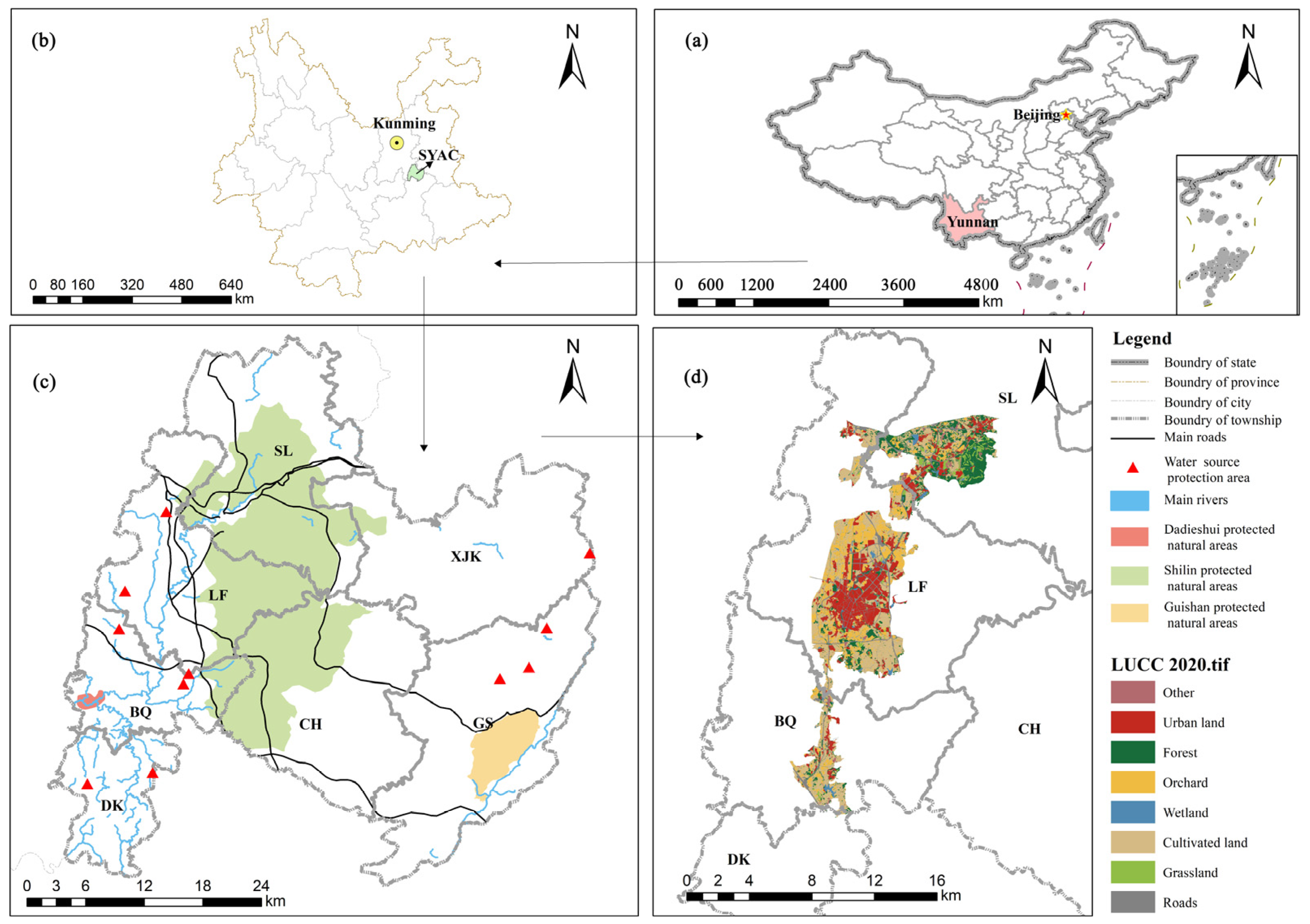
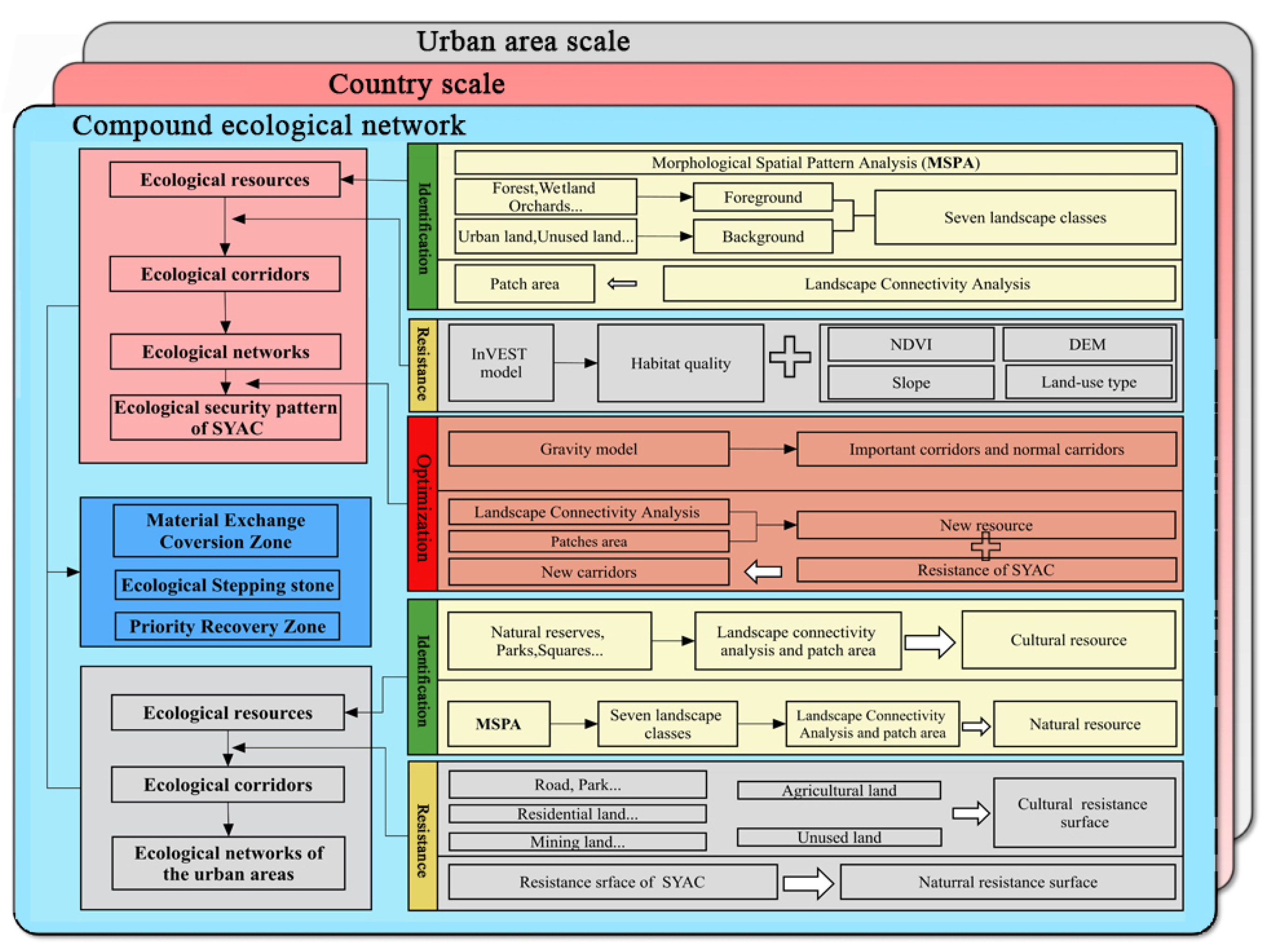

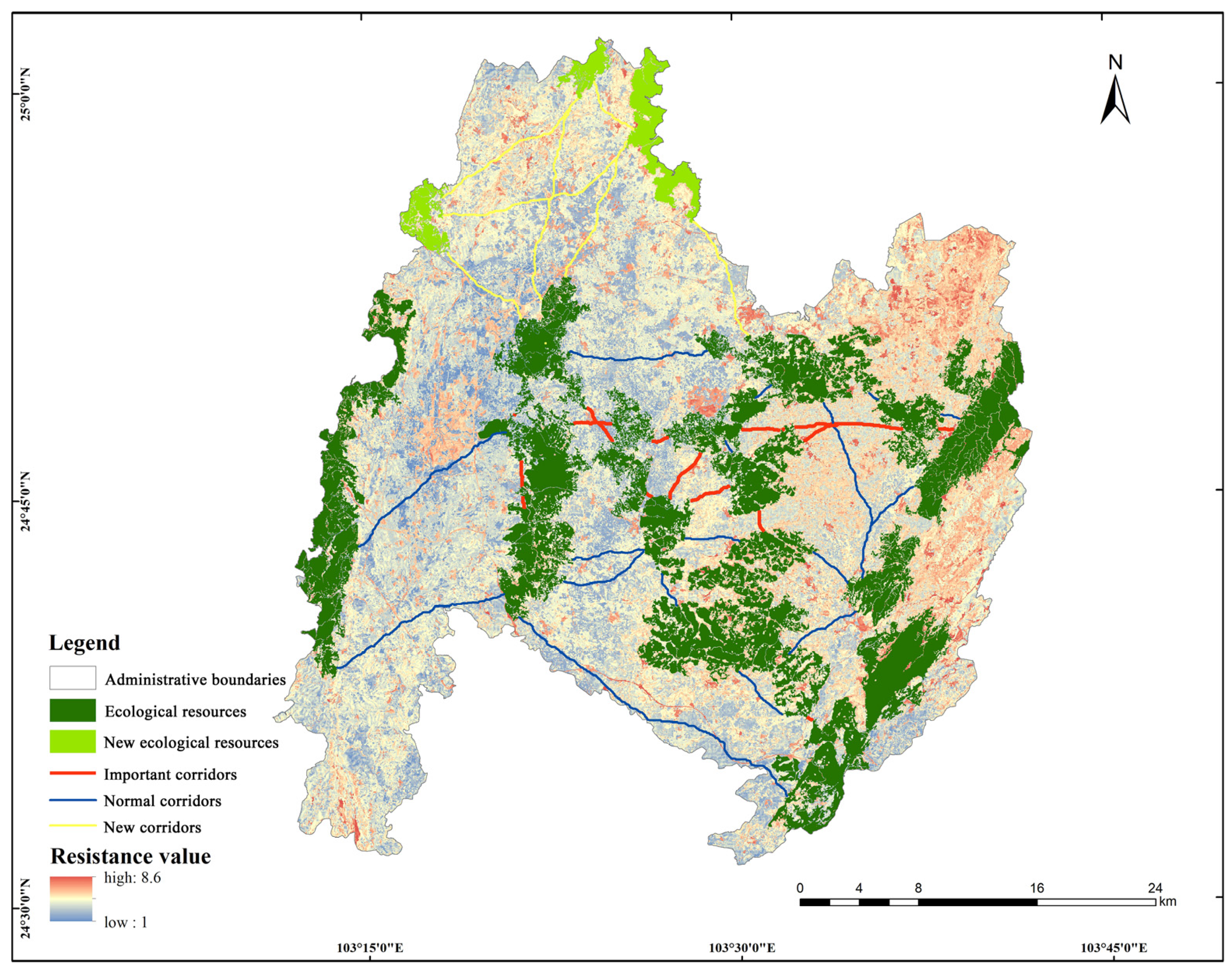
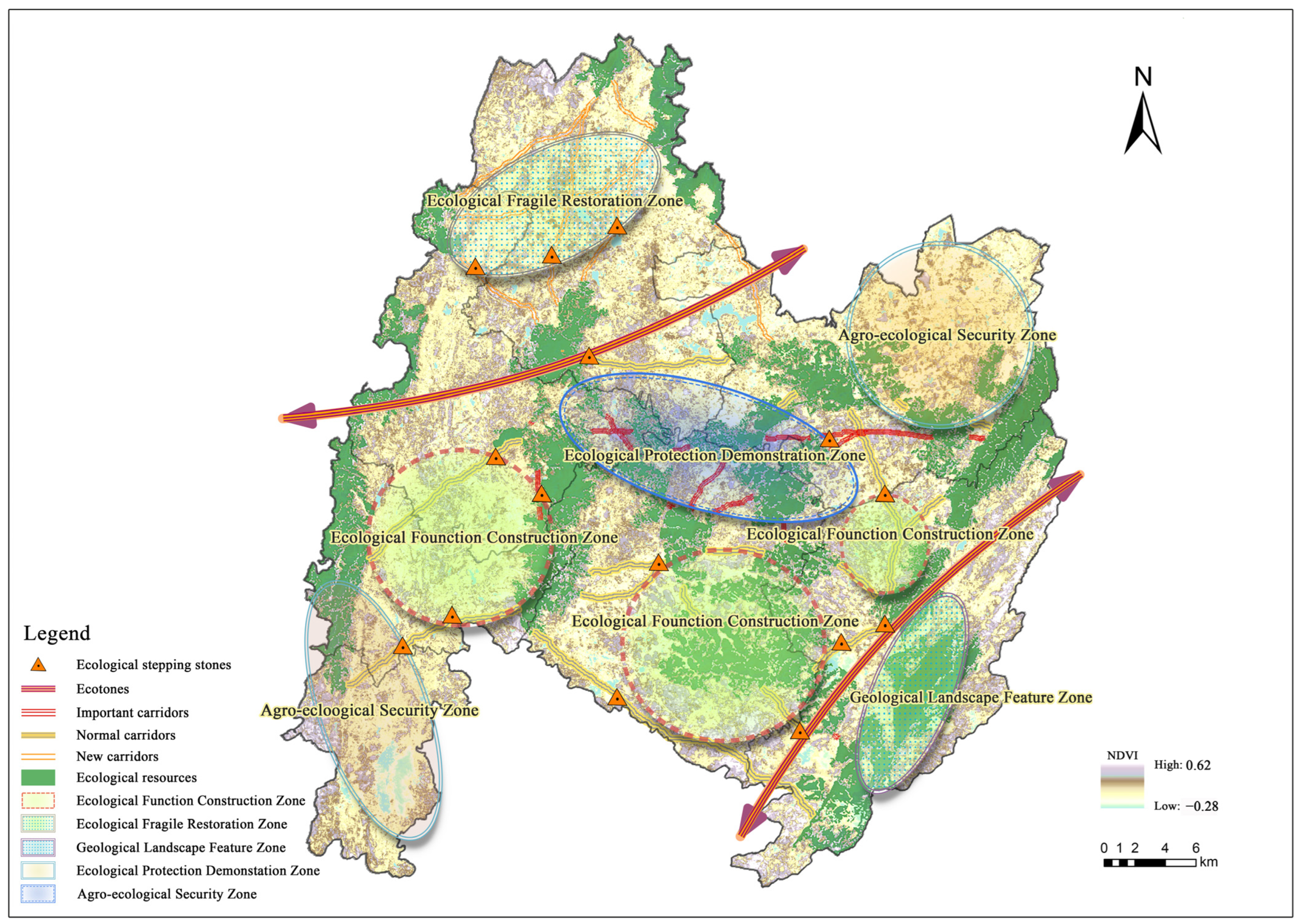
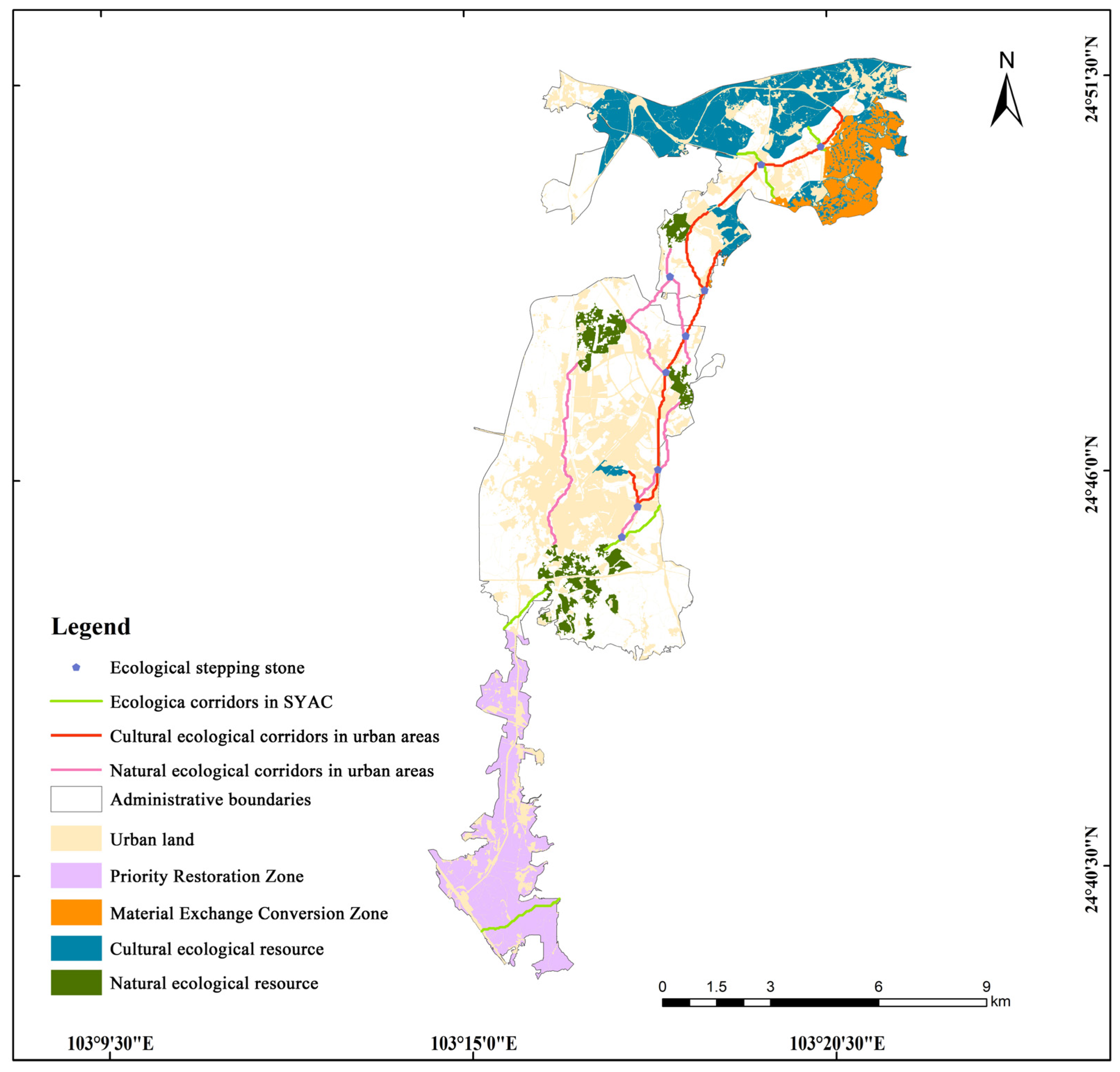

| Stress Factors | Maximum Influence Range (km) | Weight | Spatial Decay Type |
|---|---|---|---|
| Cultivated land | 0.8 | 1 | linear |
| Urban land | 0.5 | 0.7 | exponential |
| Mining land | 0.3 | 0.2 | exponential |
| Unused land | 0.3 | 0.2 | exponential |
| Resistance Factor | Weight | Resistance Coefficient | ||||
|---|---|---|---|---|---|---|
| 1 | 3 | 5 | 7 | 9 | ||
| Habitat quality index | 0.3 | 0.6–1 | 0.3–0.6 | 0.2–0.3 | 0.1–0.2 | 0–0.1 |
| NDVI | 0.1 | 0–6.46 | 6.45–14.30 | 14.30–22.79 | 22.79–33.97 | 33.97–73.86 |
| DEM (m) | 0.25 | 1458–1789 | 1789–1914 | 1914–2020 | 2020–2159 | 2159–2596 |
| Slope (°) | 0.25 | 0–4.34 | 4.34–11.59 | 11.59–20.28 | 20.28–31.86 | 31.86–73.86 |
| Land-use type | 0.1 | Forest | Cultivated land | Wetland | Unused land | Urban land |
| Land Use Type | Resistance Coefficient |
|---|---|
| Roads; Land for public facilities, Science, Education, Culture, and Health; Park; Transportation service stations; Commercial service facility land | 1 |
| Residential land | 3 |
| Mining land; Industrial Land; Airport; Press and publication administration; Water conservancy facilities land; Specially designated land; Land for logistics and warehouse | 20 |
| Agricultural land | 100 |
| Unused land | 300 |
| Node | Area (km2) | dPC | Node | Area (km2) | dPC |
|---|---|---|---|---|---|
| 1 | 10.6426 | 34.72 | 10 | 17.1679 | 10.75 |
| 2 | 39.4164 | 29.9 | 11 | 14.3395 | 8.98 |
| 3 | 45.9692 | 28.31 | 12 | 12.5189 | 8.8 |
| 4 | 21.0178 | 24.67 | 13 | 6.1879 | 8.8 |
| 5 | 34.476 | 22.82 | 14 | 3.6599 | 7.58 |
| 6 | 24.2884 | 19.09 | 15 | 3.7699 | 6.93 |
| 7 | 10.1636 | 12.49 | 16 | 3.1858 | 6.51 |
| 8 | 19.1681 | 11.72 | 17 | 7.5568 | 4.85 |
| 9 | 9.9222 | 10.82 | 18 | 43.0611 | 3.95 |
Disclaimer/Publisher’s Note: The statements, opinions and data contained in all publications are solely those of the individual author(s) and contributor(s) and not of MDPI and/or the editor(s). MDPI and/or the editor(s) disclaim responsibility for any injury to people or property resulting from any ideas, methods, instructions or products referred to in the content. |
© 2023 by the authors. Licensee MDPI, Basel, Switzerland. This article is an open access article distributed under the terms and conditions of the Creative Commons Attribution (CC BY) license (https://creativecommons.org/licenses/by/4.0/).
Share and Cite
Miao, X.; Leng, C.; Dai, S.; Jin, J.; Peng, J. Construction of Multi-Level Ecological Security Pattern for World Natural Heritage Sites from the Perspective of Coupling and Coordination between Humans and Nature: A Case Study of Shilin Yi Autonomous County, China. Sustainability 2023, 15, 15052. https://doi.org/10.3390/su152015052
Miao X, Leng C, Dai S, Jin J, Peng J. Construction of Multi-Level Ecological Security Pattern for World Natural Heritage Sites from the Perspective of Coupling and Coordination between Humans and Nature: A Case Study of Shilin Yi Autonomous County, China. Sustainability. 2023; 15(20):15052. https://doi.org/10.3390/su152015052
Chicago/Turabian StyleMiao, Xue, Congbin Leng, Shiyu Dai, Jing Jin, and Jiansong Peng. 2023. "Construction of Multi-Level Ecological Security Pattern for World Natural Heritage Sites from the Perspective of Coupling and Coordination between Humans and Nature: A Case Study of Shilin Yi Autonomous County, China" Sustainability 15, no. 20: 15052. https://doi.org/10.3390/su152015052
APA StyleMiao, X., Leng, C., Dai, S., Jin, J., & Peng, J. (2023). Construction of Multi-Level Ecological Security Pattern for World Natural Heritage Sites from the Perspective of Coupling and Coordination between Humans and Nature: A Case Study of Shilin Yi Autonomous County, China. Sustainability, 15(20), 15052. https://doi.org/10.3390/su152015052






